Those of us new to chickens and living on small city lots aren’t able to follow a lot of traditional chicken-keeping practices. Full-time free-ranging is out, for one, and all the advantages that it offers. So are the benefits of keeping a rooster to guard and guide the flock. And we generally can’t let chicken math totally take control (believe me, I’ve tried). But with a few tweaks, we, too, can enjoy the company, antics, and outputs of small feathered beings. Here are a few tips that my family has cobbled together during our chicken-keeping adventure so far.

1. Consider sticking with bantams, at least for the most part.
We started with mostly large fowl and just one bantam. But we quickly came to realize that our bantam was our most charming flock member, and she turned out to be one of our more reliable layers, too. Then, by the end of the first year, it became clear that the big girls were doing LOTS of damage to our small backyard and mini-orchard. The bantams were much much easier on the landscaping. Plus, we get twice the personalities and entertainment within the same space as before! We’ve gradually rehomed the surviving standard hens and currently have six bantam hens and a small hatch of four chicks coming up to start laying in spring.
2. Determine what your primary goal is (eggs, lawn ornaments, companions, etc.) and choose your breeds accordingly.
Our main focus is eggs, followed by manure. We have limited space and time to manage our flock, what with those pesky jobs and our two engaging but rambunctious dogs, and of course our human children. We select bantam varieties that lay at least 180 eggs/year, except for a silkie frizzle as a broody (we also love to raise chicks). We try to have two or three different breeds that tend to lay heavily at different times (some in heat, some in winter, etc.). There’s still enough choice that we can pick ones we like the looks of. We have found that pretty much anything you might want chicken-wise is available in a bantam-sized package!
If a hen doesn’t live up to her billing on egg production, we find her a home with friends and fellow local chicken-lovers who have space for a few novelty chickens. If she bullies other hens, acts aggressively toward us, or keeps getting out of the pen and into harm’s way (one of the dogs has a strong prey drive), we likewise rehome her. This keeps flock management issues – and our children’s tears - down quite a bit.

3. Remember vertical space when planning your chickens’ area.
Bantams (except silkies) generally fly well, so we try to use this to our advantage by providing lots of vertical space in the coop and run, with plenty of high perches. We’ve learned the hard way how much damage the girls can do to a yard, so we now keep them in a large pen around the coop and run where they browse and scratch during clear weather. If we need to leave them in their coop because it’s too wet (for them or for us), or we just don’t have time to get out there and let them out, there’s plenty of room in the coop and run to keep the peace for up to a week or so, and they have healthy spots to sit when it’s so wet that the floor of the coop and run can’t drain quickly enough.
4. Place your coop thoughtfully and take the time to pretty it up.
When you have a city-sized backyard, you’re going to be looking at that coop a LOT. We bought a pre-fab coop that we all liked and then built our run to match it. Now when we’re out back with the dogs or working in the yard, the coop adds to our enjoyment of the space. And we were able to place our coop/run in line with some of our windows so we can easily see what our girls are getting up to when we need to without going outside in the cold or wet.

5. Check in with the neighbors and get them on board.
The best advice I ever got about keeping chickens in the city! We talked with our next-door neighbors in advance, got their okay (it helped that one of them had kept chickens as a child), and brought their kids and grandkids over to play with the new chicks. We give them an occasional dozen eggs and ask them to have their kids collect eggs when we’re away from home (kids LOVE bantam eggs). Any issues that have come up have been easy to solve with this foundation in place.
6. Predator-proof as if you’re in the country.
We have seen raccoons, gopher snakes, skunks, hawks, and the occasional fox wander through our neighborhood, as well as the expected city predators: cats, rats, and dogs (mainly our own dogs!). We have hardware cloth 18-24 inches all around the base of our coop and run, and the run is covered. We make sure there is also cover from hawks in the pen with shade structures and such. Even so, we lost a pair of layers one night when we forgot to shut up the coop, and an egg from under a broody hen (still not sure how that happened). Just ‘cause you’re city folks doesn’t mean you don’t have wildlife!

7. Consider managing your chickens as part of your yard’s ecosystem.
Chickens make poop – a lot of it. They also eat plants and scratch up the ground. These facts can cause problems when they’re not planned for (stinky chicken run, ruined landscaping, or vegetable gardens). But when these things work together, they can improve the health of both your chickens and your yard. Harvey Ussery’s The Small-Scale Poultry Flock is an invaluable resource for information and guidance in setting up complementary systems taking advantage of your chickens’ natural behaviors and attributes.
At our house, this means that we plant sections of our yard and vegetable garden with cover crops like clovers and alfalfa that do triple duty as green mulch, biomass for composting, and chicken forage. I trim some of these, plus a few handfuls of grass clippings from our very small lawn, and feed them to the girls several times weekly. All yard, vegetable garden, and kitchen waste safe for chicken consumption goes into the chickens’ pen along with the mucked-out bedding and manure from the coop and run. The girls have plenty to eat and scratch at for entertainment even in a relatively small space. The compost breeds various bugs and grubs for them to eat as they turn it over. And the constant addition of green and brown matter keeps things in balance so that the pen doesn’t have an unpleasant odor. Just before the fall rains start, we muck out the pen and spread the compost around our dwarfed fruit trees and roses, then collect the fallen leaves from the backyard and put them in the pen to start the cycle over again.

As you can see, chicken-keeping in a small city lot doesn't have to be an unending series of chicken management battles. In fact, with a bit of forethought, city chicken-keeping can feed your yard, household, chicken addiction - and soul!
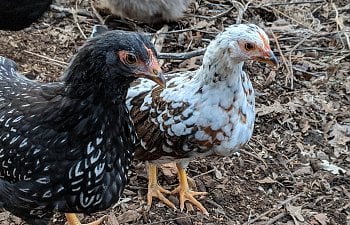
1. Consider sticking with bantams, at least for the most part.
We started with mostly large fowl and just one bantam. But we quickly came to realize that our bantam was our most charming flock member, and she turned out to be one of our more reliable layers, too. Then, by the end of the first year, it became clear that the big girls were doing LOTS of damage to our small backyard and mini-orchard. The bantams were much much easier on the landscaping. Plus, we get twice the personalities and entertainment within the same space as before! We’ve gradually rehomed the surviving standard hens and currently have six bantam hens and a small hatch of four chicks coming up to start laying in spring.
2. Determine what your primary goal is (eggs, lawn ornaments, companions, etc.) and choose your breeds accordingly.
Our main focus is eggs, followed by manure. We have limited space and time to manage our flock, what with those pesky jobs and our two engaging but rambunctious dogs, and of course our human children. We select bantam varieties that lay at least 180 eggs/year, except for a silkie frizzle as a broody (we also love to raise chicks). We try to have two or three different breeds that tend to lay heavily at different times (some in heat, some in winter, etc.). There’s still enough choice that we can pick ones we like the looks of. We have found that pretty much anything you might want chicken-wise is available in a bantam-sized package!
If a hen doesn’t live up to her billing on egg production, we find her a home with friends and fellow local chicken-lovers who have space for a few novelty chickens. If she bullies other hens, acts aggressively toward us, or keeps getting out of the pen and into harm’s way (one of the dogs has a strong prey drive), we likewise rehome her. This keeps flock management issues – and our children’s tears - down quite a bit.
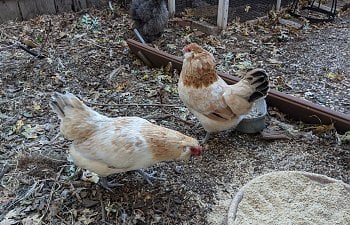
3. Remember vertical space when planning your chickens’ area.
Bantams (except silkies) generally fly well, so we try to use this to our advantage by providing lots of vertical space in the coop and run, with plenty of high perches. We’ve learned the hard way how much damage the girls can do to a yard, so we now keep them in a large pen around the coop and run where they browse and scratch during clear weather. If we need to leave them in their coop because it’s too wet (for them or for us), or we just don’t have time to get out there and let them out, there’s plenty of room in the coop and run to keep the peace for up to a week or so, and they have healthy spots to sit when it’s so wet that the floor of the coop and run can’t drain quickly enough.
4. Place your coop thoughtfully and take the time to pretty it up.
When you have a city-sized backyard, you’re going to be looking at that coop a LOT. We bought a pre-fab coop that we all liked and then built our run to match it. Now when we’re out back with the dogs or working in the yard, the coop adds to our enjoyment of the space. And we were able to place our coop/run in line with some of our windows so we can easily see what our girls are getting up to when we need to without going outside in the cold or wet.
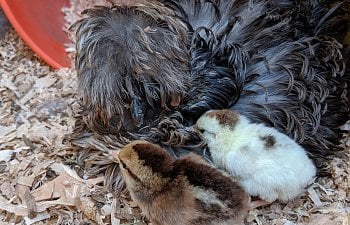
5. Check in with the neighbors and get them on board.
The best advice I ever got about keeping chickens in the city! We talked with our next-door neighbors in advance, got their okay (it helped that one of them had kept chickens as a child), and brought their kids and grandkids over to play with the new chicks. We give them an occasional dozen eggs and ask them to have their kids collect eggs when we’re away from home (kids LOVE bantam eggs). Any issues that have come up have been easy to solve with this foundation in place.
6. Predator-proof as if you’re in the country.
We have seen raccoons, gopher snakes, skunks, hawks, and the occasional fox wander through our neighborhood, as well as the expected city predators: cats, rats, and dogs (mainly our own dogs!). We have hardware cloth 18-24 inches all around the base of our coop and run, and the run is covered. We make sure there is also cover from hawks in the pen with shade structures and such. Even so, we lost a pair of layers one night when we forgot to shut up the coop, and an egg from under a broody hen (still not sure how that happened). Just ‘cause you’re city folks doesn’t mean you don’t have wildlife!
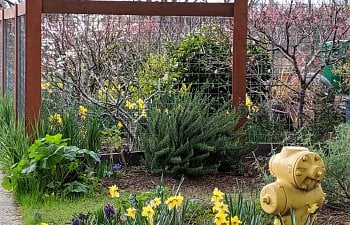
7. Consider managing your chickens as part of your yard’s ecosystem.
Chickens make poop – a lot of it. They also eat plants and scratch up the ground. These facts can cause problems when they’re not planned for (stinky chicken run, ruined landscaping, or vegetable gardens). But when these things work together, they can improve the health of both your chickens and your yard. Harvey Ussery’s The Small-Scale Poultry Flock is an invaluable resource for information and guidance in setting up complementary systems taking advantage of your chickens’ natural behaviors and attributes.
At our house, this means that we plant sections of our yard and vegetable garden with cover crops like clovers and alfalfa that do triple duty as green mulch, biomass for composting, and chicken forage. I trim some of these, plus a few handfuls of grass clippings from our very small lawn, and feed them to the girls several times weekly. All yard, vegetable garden, and kitchen waste safe for chicken consumption goes into the chickens’ pen along with the mucked-out bedding and manure from the coop and run. The girls have plenty to eat and scratch at for entertainment even in a relatively small space. The compost breeds various bugs and grubs for them to eat as they turn it over. And the constant addition of green and brown matter keeps things in balance so that the pen doesn’t have an unpleasant odor. Just before the fall rains start, we muck out the pen and spread the compost around our dwarfed fruit trees and roses, then collect the fallen leaves from the backyard and put them in the pen to start the cycle over again.
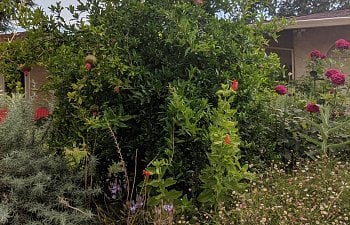
As you can see, chicken-keeping in a small city lot doesn't have to be an unending series of chicken management battles. In fact, with a bit of forethought, city chicken-keeping can feed your yard, household, chicken addiction - and soul!
